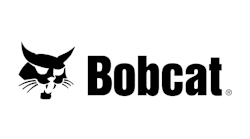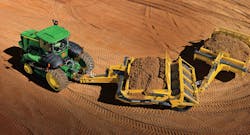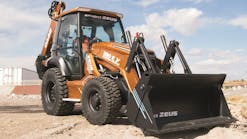Editor’s note: This article first appeared in October 2015.
“Our wheel loaders are all-around good utility machines for a heavy civil job site,” says Tommy Tynes, maintenance manager for Sundt Construction, a Tempe, AZ-based general contractor. “Our people use them with forks; we have quick couplers on the fronts so we can use a fork or a boom for setting pipe. We use them for backfilling pipe trenches, for picking and carrying concrete boxes, or pipe, or whatever needs carrying.
“We also use them for loading aggregate into trucks,” says Tynes. “We have a soil cement plant and two concrete plants. Typically we use our Caterpillar 966H for loading aggregate, but we can use a Cat 950 for the smaller plants.”
Editor's note: This article first appeared in October 2015. “Our wheel loaders are all-around good utility machines for a heavy civil job site,” says Tommy Tynes, maintenance manager for Sundt Construction, a Tempe, AZ-based general contractor. “Our people use them with forks; we have quick couplers on the fronts so we can use a fork or a boom for setting pipe. We use them for backfilling pipe trenches, for picking and carrying concrete boxes, or pipe, or whatever needs carrying. “We also use them for loading aggregate into trucks,” says Tynes. “We have a soil cement plant and two concrete plants. Typically we use our Caterpillar 966H for loading aggregate, but we can use a Cat 950 for the smaller plants.”Sundt is an employee-owned company that works nationwide, but most jobs are west of the Mississippi River. Sundt buys all of its loaders new from the Arizona Caterpillar dealer, Empire Southwest. “We like to run newer equipment so that we can eliminate as much downtime as possible,” says Tynes. “We run them for about 10,000 hours and then we trade them in—sell them and purchase new ones. We buy them new because of the Caterpillar product—the support and service and price that we can get them at.”
Tynes says Sundt operators like the back-up cameras on the newer Cat loaders. The company owns 11 Caterpillar loaders, and seven are the 950-size machines. Tynes says the back-up cameras are a welcome feature on newer loaders because the exhaust emissions control equipment has required a higher hood in back, and that reduces visibility to the rear of the machine. “The 950 was a good machine for working around utilities and tight corners,” says Tynes. “Now with the higher hoods, they’ve gotten a little bit harder to see out of and they’re a little bit bigger. We’re still making them work, but a lot of times when you get into tighter areas we like to use a smaller machine like a 930-size model.”
Empire’s service and parts availability are impeccable, says Tynes. “We have a good dealer system that takes good care of us,” he says. “They’re very good at it—that’s one of the big selling points of Caterpillar. We can put a lot of hours on a machine, and if it goes down and is out of warranty, the Cat dealer jumps in and helps us with it. If necessary, the dealer talks to the factory and gets support from them.”
Earlier this year Caterpillar announced two new loaders at World of Asphalt—the 966M XE and the 972M XE. Both have a Tier 4 Final-certified engine. The 966M runs a 298-horsepower Cat engine and can employ buckets from 3.25–12 cubic yards in size. The 972M runs a 311-horsepower Cat ACERT engine and carries buckets from 3.75 up to 13 cubic yards (lighter material).
Caterpillar says its ACERT engines meet Final Tier 4 standards with a combination of proven electronic, fuel, air, and aftertreatment components. The two loaders have been “designed to deliver superior performance and fuel efficiency while simplifying the operator’s interface and operating technique,” says a representative from Caterpillar.
K-Five Construction Co., a heavy/highway contractor based in south suburban Chicago, owns 17 wheel loaders, and 13 of them are Caterpillar machines. Two are John Deere loaders and two are Komatsu loaders. Seven of the loaders are used at K-Five’s asphalt plants, and the company has two concrete batch plants as well.
To make plant operations more efficient, K-Five recently brought its aggregate stockpiles closer together at the plants and improved their working surfaces. Because the loaders then did not have to travel as far to charge the plants, K-Five could use a smaller loader. As a result of those changes, the company figures it is saving 30–35% on loader fuel, compared to previous operations.
“We shrunk everything down so the loaders don’t have to travel as far,” says Dave Gorski, equipment manager at K-Five. “We downsized our loaders from nine-plus yards to eight-and-a-half-yard loaders. We went from Cat 988 loaders to Cat 980 size machines. The combination of things saved us about 30% on fuel.”








